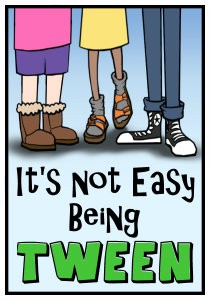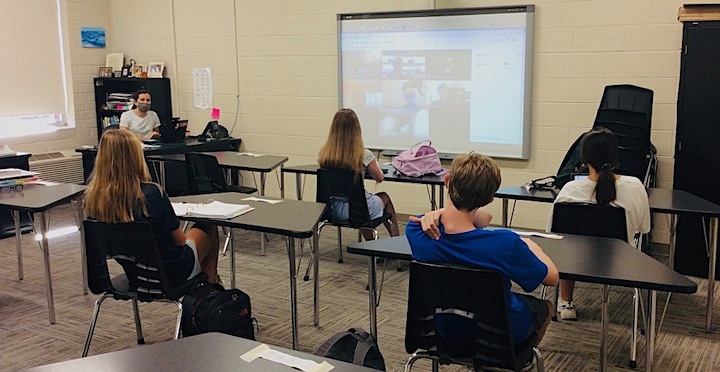A Hybrid Companion for Middle Level Teaching
A MiddleWeb Blog

I can now add COVID-19 to this list. Other than the advent of the internet, I cannot think of anything that has impacted our profession as profoundly in decades.
Students and teachers alike are navigating these uncharted waters with mixed results. Teaching virtually, in-person with social distancing and masks, or a hybrid of both (as my school is doing) presents challenges I’ve never experienced.
I am trying to rise to the challenge, but some days are better than others. This school year is a work in progress for teachers everywhere, and I don’t see that changing any time soon.
Now that I’ve been doing the hybrid model since September, I have found some ways to make teaching students simultaneously at home and in front of me work a bit better for all concerned, and I’d like to share them here.
Although it is often noted that our students are digital natives and grew up with computers, my experience with having them use technology for more than just surfing the internet is mixed. There is a lot they don’t know how to do when it comes to productivity and organization.
We cannot assume our students are able to handle the tremendous responsibility and executive functioning necessary to do what we are asking them to do without support. To provide that support and help make our current situation work a bit better, I believe we need to —
✻ Help students strengthen their organization skills;
✻ Adapt our methods with adolescent learners in mind, and
✻ Modify our curriculum.

Ideas for supporting student organization
►Offer directions in multiple formats and share them in several locations. Our school has an intranet where we post daily assignments as well as materials for longer-term projects. Any learning platform or other shared space can serve.
►Plan for transitions during class – especially between those that use technology and those that use paper. Too much down time makes it difficult to maintain their attention. Instead, establish a routine such as silent reading, a quickwrite, or an exit slip as something they can be doing while you switch gears.
►Whenever I give a long-term assignment, I provide a calendar with all interim due-dates and check-in points filled in. I post this on our intranet and give them a hard copy.
►Provide checklists and conduct interim check-ins for projects and longer assignments.
►Help students develop a plan for their own organization and what to do if they get stuck.

This year, my classes were shortened and it became a logistical nightmare to have students check out books from my classroom library, so I have substituted listening to an episode of the Six Minute podcast from Kids Listen. It has been enjoyable for all of us, and it is something we look forward to every day.
Ideas for adapting our methods
►First and foremost, we must slow down our pacing. There is no possible way we will be able to cover all the material we have in the past, nor should that be the expectation. These are unusual times and our students will not be irreparably harmed if we go more slowly.
►Prioritize the crucial skills and material your students need to learn and explain to them why they are important. Sometimes just letting students know why they are learning something helps increase their engagement with the topic.
►Whenever possible, conduct some sort of pre-assessment to determine what they already know so that you are not wasting the valuable instructional time you do have.
►Don’t overwhelm students with too much new technology. Introducing a new tool every day or even every week can quickly become too much to manage.
►Utilize guided or “skeleton” notes and graphic organizers to help students know what material is of primary importance.
►Allow extra time for and invite clarifying questions.
►Allow time in class for students to begin their work so that you can troubleshoot in real-time rather than through emails in the evening.
►Provide as much feedback as possible as quickly as you can so students do not feel they are submitting their work into a void.
►Use techniques that allow for collaboration such as online curation sites, an online whiteboard feature, or other discussion tool that allows or requires everyone to have input in ways other than just on-the-spot via video.
Ideas for modifying our curriculum
►Consider adding virtual field trips to change things up. There is a wealth of engaging resources online that can supplement your instruction and break up the routine. You can also turn the table and invite students to create and share a virtual field trip of their own on a topic they choose.
►Although it is always a best practice, incorporating choice as much as possible is crucial now. I recently gave my students a tic-tac-toe literary response assignment that included opportunities for analysis as well as creative writing and it was a big hit. They actually said writing their responses was fun! (Here are some “think-tac-toe” ideas from Carol Ann Tomlinson.)
►Another best practice that helps keep students engaged and motivated is to incorporate work that involves problem solving using inductive and deductive reasoning. Projects that students can complete independently are preferable, and frankly necessary, right now, rather than those done as a group. Students enjoy the productive struggle and it is more stimulating that rote work.
►Incorporate multi-modal supplemental resources through hyperdocs (a favorite of mine) for students to work through at their own pace.
►If possible, add a remote guest speaker to your classroom. My students are going to have the opportunity to speak with the authors of the class novel we are reading, and I could not be more excited! My colleague recently had a scientist from a local museum speak to her science classes. You could show a TED talk or a video clip from an educational TV channel.
►In the spirit of using Universal Design for Learning strategies, provide multiple ways for students to demonstrate their learning, especially now when online testing provides some logistical and ethical dilemmas.
►Speaking of assessments, this is the perfect time to refine tests, quizzes, and projects to incorporate original, higher-level thinking and application of skills rather than solely comprehension and recall items. If we make sure original thought is required, we help address any academic integrity issues such as plagiarism or cheating on an assessment.
►Finally, now is the time to pull out and dust off all your tried-and-true, sure-fire-hit assignments from the past and adapt them to your current situation. After all, if you are bored with what you’ve been teaching, so are your students.
What are your ideas?
I hope you found something useful here, and I would love to hear some of your ideas as well. We are all in this together – no matter the format your class has taken this year – and I wish us all a happy and healthy fall and winter, with the promise of a renewal in spring.


































Cheryl,
As a veteran educator myself, 22 years, I enjoyed reading your blog. It reassured me that it is okay to go slow and not become overwhelmed. I am now teaching all virtual and have a really hard time getting kids to speak up when they don’t know what to do. Any suggestions?
Thanks, Colleen
Hi Colleen,
Thank you so much.
I found these suggestions from Jen Serravallo very helpful.
https://www.middleweb.com/43809/jen-serravallo-let-go-and-gain-engagement/